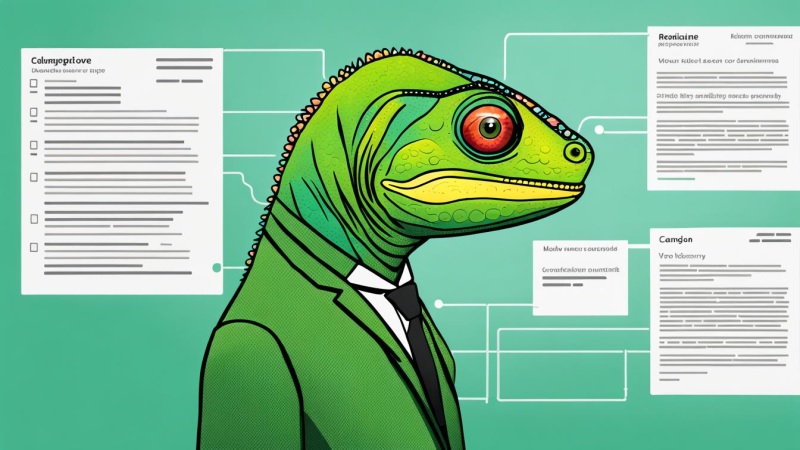Creating a successful CV: Tips and tricks for an impressive CV.

Creating a successful CV
In the dynamic world of information technology, a well-written curriculum vitae (CV) is an essential tool for professionals in the field.
An impressive resume not only opens the door to exciting career opportunities, but also helps you highlight your skills and experience in a way that catches the attention of IT employers.
This article provides important steps to create a resume that meets the needs of IT professionals. We analyze each section of your resume and provide specific tips to maximize your IT experience, skills, and knowledge.
Whether you’re just starting your career in the technology industry or are a seasoned professional looking for new opportunities, this guide will give you the tools you need to create a compelling resume.
As we review each section of your resume, we provide practical tips and tricks to help you stand out from the crowd and impress IT employers.
Every aspect of your resume has a specific purpose, and knowing how to optimize your resume can give you a huge advantage in the hiring process. Let’s work together to create a resume that properly reflects your potential and expertise in the technology field.
Personal Information and Professional Presentation
The personal information section and job summary are important starting points for an IT professional’s resume.
This section should be well-structured so that it immediately catches the employer’s attention and provides a brief overview of your qualifications and career goals.
Here are some important tips for properly structuring this section.
Personal information
- Name: Include your full name, but avoid titles or abbreviations that would be inappropriate for a technical resume.
Tip: Make sure your name is clearly visible and easy to read.
- Address: Enter your full address, or at least your geographic location (city, state, country).
Tip: Make sure your address is up to date.
- Phone number: Please enter a valid phone number and make sure you can make a call.
Tip: Check your voicemail for missed calls.
- Email address: Use a professional email address that includes your name and looks legitimate.
Tip: Avoid addresses that are too informal or inappropriate.
Professional overview
Impress employers with your skills and experience with a professional summary. Correct construction is important.
It’s done like this:
- Overview: Start with a clear and concise statement that highlights your key skills and experience.
Tip: Avoid clichés and be concise.
- Career Goals: What are your goals? Are you an expert? What kind of contributions do you make in the technical field?
- Tip: Set realistic and relevant goals.
- Strengths: Highlight your most important skills and abilities. Examples: web development, cybersecurity, data analysis.
- Tip: List only relevant skills.
- Added value: Finally, summarize how your experience and skills add value to the employer.
- Tip: Highlight how you are helping solve a problem or improve a process.
This section will determine your first impression. So make sure every word counts. Keep IT-related content concise and clear. Avoid vagueness and exaggeration. Be honest and focus on what makes you unique and valuable to an employer.
Previous professional experience and projects
Previous professional experience and projects form the backbone of an IT professional’s resume. In this section, I will detail my previous work and the skills I have developed. Here’s how to structure and highlight this important information, including tips to make your experience stand out.
Experience
- Correct list: List all previously held positions in reverse chronological order from newest to oldest. Enter company name, location, title, years of service, etc.
- Concise Description: Provide a concise description of each position’s primary responsibilities and accomplishments. Highlight the major projects you were involved in and how you added value to the company.
- Use keywords: Use technology-specific keywords in your description, such as: b. “Front-end development,” “database management,” or “cyber security.” These keywords will make it easier for employers to search your resume.
Previous projects
Project details: Highlight technology projects you’ve worked on in the past. Provide details of the project objectives, technology used, and results achieved.
Highlight accomplishments: Don’t limit yourself to task descriptions. Highlight the success and impact of each project.
Read the full story: “We built a successful mobile app that increased conversions by 20% in 6 months.”
Portfolio or Link: If possible, please include a link to your project or an online portfolio showcasing your previous work.
Tips about your professional career and past projects
- Customize: Tailor your description and benefits to the requirements of the job you’re applying for. You can highlight specific experience and skills related to a specific position.
- Highlight your contributions: Focus on how you added value to previous companies and projects. Show that you exceeded expectations and delivered benefits.
- Use numbers and statistics: Add numbers and statistics to your descriptions whenever possible. For example, you could mention how you optimized the performance of your application, resulting in a 30% reduction in load time.
- Be concise: Emphasize important points, but be concise. Employers often look through resumes to understand the information.
This section gives you the opportunity to show what you have achieved so far and how you are suitable for the position you are applying for. Be specific and relevant to highlight your experience and increase your chances of being selected for an interview.
Technical and Soft Skills
An IT professional’s resume should highlight not only his technical knowledge and skills, but also his soft skills that make a difference in the IT world.
This section allows you to highlight the strengths that make you a valuable candidate. Here’s how to structure this section and some tips to highlight your skills.
Technical skills
- Specific list: List the technical skills you have. This may include knowledge of programming languages (Java, Python, JavaScript, etc.), database management knowledge, operating system experience, cybersecurity, web development, or other areas related to the desired position.
- Skill Level: Highlights the skill level for each skill, from beginner to intermediate to expert.
- Certifications and Certifications: If you have any technical certifications, please list them in this section to demonstrate your expertise.
Technical skills tips
- Adapt to job requirements: Adapt this section to the requirements of the position you are applying for. List only skills that are relevant to the job.
- Highlight important skills: Highlight skills that are essential to the IT field and the position you are applying for. If you are a front-end developer, emphasize knowledge of HTML, CSS, and JavaScript. Example: If possible, please provide specific examples of how you have utilized your skills on previous projects.
- Certifications and Credentials: Highlight relevant certifications or credentials that support the listed technical skills.
Software knowledge
- Effective Communication: Demonstrates the ability to communicate effectively with co-workers, customers, team members, etc.
- Problem Solving: We value the ability to solve complex and innovative problems and make informed decisions.
- Teamwork: Shows how well you work with others and contribute to the team.
- Project management: If you’ve held a position that involved project management, highlight your planning and coordination skills.
Soft skills tips
- Emphasize context: Don’t just list soft skills. Please give us a specific example of how you used it effectively.
For example, instead of saying “communication skills,” you could write “work closely with development teams to clarify project requirements.”
- Value fit: Try to demonstrate how your skills fit with the values and culture of the company you’re applying to.
For example, if your company values innovation, highlight how it has contributed to the development of new ideas in the past.
- Demonstrate results: If possible, highlight tangible results achieved through soft skills.
For example: “Effective team management completed the project two weeks early.”
This area gives you the opportunity to demonstrate what you have accomplished so far and how you are a good fit for the position you are applying for. given. When listing your skills, be specific and relevant to highlight what sets you apart from other applicants.
Education and Skills
Education and certifications are important parts of an IT professional’s resume. This section allows employers to understand your educational background and preparation for an IT career. Here’s how to structure and emphasize this section, and some helpful tips.
Education
- Correct list: List the universities you graduated from, starting with the most recent. Include the institution’s name, location, degree title (e.g., Bachelor’s degree in Computer Science), and length of study.
- Academic Achievement: If you can demonstrate significant academic achievement. For example, list honors, scholarships, etc. in this section.
- Thesis or Dissertation: If the thesis or thesis is related to his IT field or the position he is applying for, please enter a brief description.
Qualifications and Certifications
- Technical Certifications: List any technical certifications you hold, such as: b. Microsoft, Cisco, or Oracle certification.
- Security certifications or specific skills: If you specialize in cybersecurity or other specific IT areas, list any relevant certifications.
- Training and qualification information.
- Relevance: Focus on education and qualifications that are relevant to the position you’re applying for. If you have a degree or certification that fits the job, highlight it.
- Encourage continuing education: If you are involved in continuing education, such as additional courses or training, mention it. This shows employers that you are committed to keeping up with new technology.
- Highlight your accomplishments: If you’ve received any special accomplishments or awards, show how it sets you apart from others. For example, ‘Advanced Honors Degree in Mathematics’.
- Check your expertise: Make sure your diploma or certification demonstrates your expertise or IT skills to make it more relevant to employers.
This section of your resume allows you to demonstrate how your educational background supports the technical qualifications and soft skills mentioned in the previous section. Make your information specific and relevant, highlighting how you have prepared for a successful career in IT.
Projects and Professional Experience
Projects and work experience are very important for an IT professional’s resume. This section allows you to demonstrate how you have applied your technical and software knowledge in practice. Here’s how to structure and emphasize this section, and some helpful tips.
Professional experience
- Correct list: List previous positions from present to present. Enter company name, location, years of service, job title, etc.
- Detailed Description: Describe your responsibilities and accomplishments in detail. In all previous posts. Highlight how you contributed to the project and solved a specific problem.
- Results and Impact: Highlight specific results you achieved in your previous job.
Example: “I led a development team and he delivered the project two weeks ahead of schedule.”
Personal or volunteer projects
Include related projects: If you have any personal or volunteer projects in the IT field, list them. Please briefly describe each project and how you contributed to it.
Professional experience and project tips
- Focus on your accomplishments: Highlight your accomplishments and the impact you’ve had in your previous roles. Employers are looking for people who can add value.
- Relevance: Focus on work experience and projects that are relevant to the position you’re applying for. Highlight experiences that support your skills and qualifications.
- Technical terminology: Use specific technical terminology to emphasize your IT knowledge. This shows the employer that they are talking to an expert.
- Provide specific examples: If possible, provide specific examples of specific projects or tasks you have completed.
This section is a valuable tool for demonstrating your experience and skills. Highlight specifically how you contributed to the success of previous organizations and personal projects.
Awards, Recognition and Professional Associations
Awards, recognition, and membership in professional organizations add authority and value to your information technology resume. This section is an opportunity to highlight your company’s industry recognition and involvement in the IT community. Here’s how to organize this section and get relevant tips.
Awards and recognition
- Good list: List awards and recognitions received in the technology field, including achievements, excellence, and significant contributions.
- Date received: Include the date you received the award or recognition to demonstrate its relevance and timeliness.
Professional bodies
- Include professional associations: If you are a member of any professional associations or organizations in the IT field, please list them here.
- Roles in clubs: If you have held leadership or volunteer roles in these clubs, please highlight them.
Advice on awards, recognition and professional associations:
- Relevance: List awards, recognition, and connections that are directly related to the IT field and the position you are applying for.
- Highlight impact: When listing awards and recognition, briefly explain how they contributed to the success of the project or organization.
- Encourage membership: If you’re a member of a professional association, highlight how this will help her stay up-to-date on IT trends and improve her skills.
- Add links or certifications: If you have official links or certifications from professional organizations, list them to prove your membership.
This section increases the credibility of your resume and shows employers that you are recognized and committed to advancing your IT career. Be proud of your awards and recognitions, but make sure they are related to the IT industry.
Technical Skills and Programming Languages
The technical skills and programming languages you possess are essential to a successful IT resume. This section focuses on key skills that can be applied in the workplace. Here’s how to organize this section and get helpful tips.
Programming languages
- List of programming languages: Highlight programming languages you know, including Java, Python, C++, and JavaScript.
- Proficiency: Indicates your proficiency in each programming language. Example: “Python Intermediate, Java Intermediate”.
Technical competency
- Be specific: List all technical skills related to the IT field. Examples: database management, web development, cybersecurity, etc.
- Skill Level: Indicates the skill level for each technical skill, from beginner to advanced.
Tech skills and programming language tips:
- Be specific: List all relevant programming languages and technical skills. The more specific you are, the clearer your skills will be.
- Prioritize: Start with the skills or programming languages that are most important for the position you’re applying for.
- Match your experience: If you’ve used these skills in previous projects or work experience, highlight this in your previous job description.
This section is the focus of your resume for IT employers. This allows you to quickly demonstrate what skills and programming languages you have, which can make a big difference in the selection process. Be sure to update this section based on the position you are applying for.
Software Knowledge and Communication Skills
In addition to technical skills, soft skills and communication skills play an important role in success in the IT sector. This section allows you to prove that you are a consummate professional and can collaborate effectively.
This section is organized as follows and displays the corresponding tips:
Soft skills
- Effective Communication: Demonstrates the ability to communicate effectively with co-workers, clients, and customers.
- Time Management: Shows you how to organize your time and manage your projects effectively.
- Problem Solving: Emphasizes the ability to find creative and effective solutions to technical problems.
Communication skills
- Presentations and Reports: Indicate whether you have experience creating technical presentations or reports.
- Collaboration: Demonstrates the ability to work as a team and collaborate with colleagues from various departments.
Soft skills and communication skills tips
- Relevance: List soft skills and communication skills that are directly related to the requirements of the job you are applying for.
- Specific Examples: If you have a specific example of a situation where your skills were essential to solving a problem or improving a process, highlight it.
- Demonstrate professional maturity: Soft skills and communication skills show employers that you are mature and willing to work well together.
This section completes the picture. As an information technology specialist. Software knowledge and communication skills are just as important as technical skills because they contribute to the effective collaboration and success of development and technical project teams.
Foreign Languages and International Experience
If you have language skills or international experience, this section of your resume will highlight your flexibility and adaptability. This section is organized as follows and includes some helpful tips.
Foreign language
- Languages you know: List all foreign languages you know and indicate the level of each language (native, advanced, intermediate, beginner, etc.).
- Certificate or Diploma: If you have a certificate or diploma in a foreign language field, please list it.
International experience
- Locations and time periods: Consider all international locations where you have lived or worked and the corresponding time periods.
- Brief Description: Please briefly describe your international experience, including previous roles and activities.
Language and international experience tips
- Relevance: Highlight your language skills and international experience if it’s relevant to the position you’re applying for. For example, if you are applying for a position that requires you to work in an international team.
- Valuable Qualifications: Having a qualification or degree in a foreign language can be a huge advantage.
- International experience: If you have worked or lived abroad, highlight how that experience makes you an attractive candidate for the position.
This section can add depth to your resume and open the door to international opportunities. The ability to communicate in a foreign language and international experience are a huge advantage in the globalized job market.
References and conclusion
The “Reference Information” section at the end of your resume provides additional information to employers about who can review and verify your qualifications and skills.
This section is followed by a conclusion that highlights the most important elements of your resume and explains the motivation for each contribution.
References
List of references: Include the names, titles, and contact information of potential references. These are usually former or current bosses or employees.
Get permission: Be sure to get permission before including it as a reference on your resume.
Conclusion
- Resume Summary: Provide a brief summary of the qualifications, skills, and experience that make you an excellent candidate for the job.
- Motivation: Describe your motivation. How do you get into the position and bring value to the company and team?
References and tips for conclusion
- Choose your references carefully. Make sure the references you list are relevant to the role you’re applying for and that you can confidently recommend.
- Contact Information: Provide accurate reference contact information to facilitate communication.
- Brevity: Keep your resume’s conclusion concise and convincing. Important points should be clearly highlighted.
These two sections form the conclusion of your resume and help the employer better understand who you are and why you are the best candidate for the job. During the selection process, make sure your references are available and willing to answer any questions about you.
Draft and Final Review
This is the final chapter of your resume and is dedicated to the final drafting and editing process. This section provides tips for creating a perfect and attractive resume.
Editing and formatting
- Review the content: Read the content carefully to ensure that all information is accurate and complete.
- Check grammar and spelling: Make sure your resume is free of grammar and spelling mistakes.
- Format: Make sure your resume is well-structured, easy to read, and follows formatting rules.
Final inspection
- Second opinion: Have someone you trust look at your resume and ask for additional feedback or revisions.
- Customize to suit your needs: Review your resume. We will adjust it according to the requirements of the job you are applying for.
Tips for drafting and final revision
Polish yourself: You need to polish your resume for the final screening. Every detail matters.
Check for consistency: Ensure that styles, fonts, and formatting are consistent throughout the document.
Experiment with different formats: Experiment with different formats and layouts to find the format that best represents your information.
Drafting and final revisions are important steps in the resume writing process. A clean, grammatically correct, and well-organized resume increases your chances of getting noticed and being selected for an interview. Keep these tips in mind to create a resume that will help you reach your career goals.
Tips and Tricks for Creating an Impressive IT Resume
This chapter provides important tips and tricks to make sure your IT resume is truly impressive and catches the attention of employers.
Focus on relevance
Tailor your resume: It’s important to tailor your resume to the job you’re applying for. Highlight skills and experience directly related to the job.
List your qualifications: Be sure to list your key qualifications and skills in the first section of your resume.
Highlight successes
- Use numbers and statistics: When describing past experiences, use numbers and statistics to illustrate the impact of success.
- Successful Projects: List relevant projects you have led or contributed to and highlight positive results.
Audio technology
- Use expressive language: Use expressive words and actions in your explanations to make an impact.
- Avoid using too much jargon: Even if you work in technology, make sure your resume is easy to understand for people who aren’t familiar with the jargon.
Drafting and Revision
- Be consistent: Make sure the style and formatting is consistent throughout your resume.
- Submit for Review: After writing, get feedback from friends and experts to improve your resume. It is of the highest quality.
Update regularly
- Ongoing maintenance: Don’t forget to update your resume regularly as you gain experience and achieve new achievements.
- Add courses and certifications: If you complete a course or earn a new certification, be sure to add it to your resume.
Duty of care
- Research the company: Before applying to a company, research the company to understand its current values, culture, and projects.
- Personalized Cover Letter: Personalize your cover letter when you send it by showing that you’ve researched the company.
By following these tips and tricks, you can create a resume that impresses employers and open the door to the IT career opportunities you want.
Do not forget to add an air of confidence and determination to your actions.
Your professional success is within your reach!







